
Health 'Insurance' at Sea: 1 2 3 4 5 6 7 8 9 10 11 12 13 Next>>
Health 'Insurance' at Sea During the Golden Age of Piracy, Page 9
Long-Term Health Care
"And as it were much to be wished, that some speedy Care were taken towards the Reception of Poor, Maim'd, and Disabled Seamen, and the Widows and Children of such who have lost their Lives in the Publick Service..." (Josiah Burchett, "To the Reader", Memoirs of Transactions at Sea During the War with France, 1703, not paginated)

A Greenwich Pensioner Wounded in the Navy's Service
From the Wellcome Collection (1813)
Many modern pirates images meant to represent a typical golden age pirate show men with eye patches, hook hands and peg legs. Such marks of sea service were not limited to pirates during the time period however. In fact, the source of these iconic sailor's prosthetics come from images of the Greenwich pensioners - men who resided in the Greenwich Hospital which was established for them during the early 18th century. This hospital was built for the long-term care of dismembered and destitute navy sailors.
Long term care was the final mechanism of support for those wounded at sea during the late 17th and early 18th centuries. Such long-term health care broadly took two forms for sailors: recompense for lasting injuries and illnesses and provision of housing for those unable to provide for themselves due to such health problems. While Burchett's quote focuses on sailors wounded in the service to England, many merchant services and pirate crews had an interest in providing for the long-term care of those who found themselves not whole or able to work as regular sailors as a result of their time spent at sea.
This section begins with a look at the merchant sailors who were again the first to provide support systems for the care of disabled sailors. It then looks at the English Navy, which provided the most comprehensive care of the long-term sick and wounded through a variety of formal and informal programs. It finishes by looking at the pirates, who provided long-term care to their wounded brethren supplied through their Articles.
Long-Term Health Care - Merchant Ships
"...we were preparing to engage [a privateer ship], when the Seamen came to me in a Body, and told me they would not fight, by Reason they said they did not understand there was any Provision made for them,
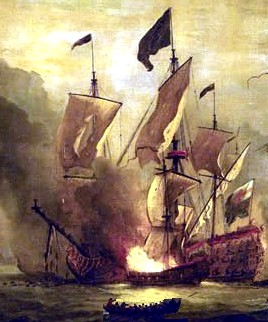
Artist: Willem van de Velde the younger
Attack on the Royal James (1672)
in case they were wounded; that if they lost a Leg or a Arm, they must be Beggers all their Life after. I told them they had a just Title to the same Benefit as any of the Men in the Queen's Ships; and to encourage them to fight, I told that I would get up a Cask of the Merchant’s Money, and to every one that received any Hurt by the Enemy in the Engagement, I would give a reasonable Gratuity as Smart-Money [a term for money given to those wounded], if we escaped; which I made no doubt of, if they would do their Duty. At this they seem’d satisfy’d, and were perswaded to get every Thing ready for fighting." (Nathaniel Uring, A history of the voyages and travels of Capt. Nathaniel Uring, p. 66-7)
While merchant vessels have the longest of history of providing something for those permanently disabled at sea, they typically had some of the weakest coverage. This was actually part of the reason a pirate's flag was such an effective weapon - many merchant sailors were unwilling to fight for such limited incentives. This is highlighted by Uring's situation. Still, both forms of long term health care - financial recompense for disabling wounds and housing for merchants sailors so wounded - were provided to some degree by various merchant companies.
The concept of recompense for wounding is quite ancient.
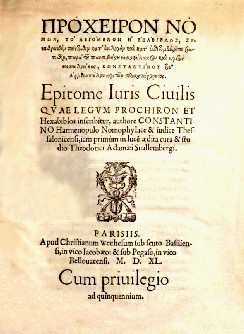
The Hexabiblos by 14th Century Byzantine Judge
Constantine
Harmenopoulos (1540 Edition)
The Rhodian Sea Law, which originated on the island of Rhodes, Greece in the 7th century, was copied by Byzantine 'universal judge' Constantine Harmenopoulos in book 2 of his Hexabiblos, published around 1344-5. One of the Rhodian laws from that book states that "If any Master, Merchant, or Mariner strike a Man with his Fist, and blind him; or if by kicking him, he bursts his Belly; besides the Doctor's Fees, he shall pay Twelve Nobles to the Person for the Loss of an Eye, and Ten Nobles for the causing of a Rupture; and if the Person so struck decease, the Striker shall be punished with Death."1 While on a much smaller scale, this is remarkably similar to some of the pirate's articles used a millennium later.
The Rhodian Sea Laws were more extensive in this regard than the laws that followed them. The 12th century Laws of Oleron, which were largely adopted by the European nations, simply state that when a man became ill in service of a merchant ship, if "he recover, he ought to have his full Wages, deducting only such Charges as the Master has been at for him [while he was healing]. And if he dies, his Wife or next Kin shall have it."2 The 1361 Laws of Wisby (Sweden) similarly state that if an ill sailor dies "his Wages shall be paid to his Widow, or to his next Heir.3 The rules for the Hansean League Merchant sailors dating to 1597 read similarly.4
There appears to have been some improvement in the pay for a merchant sailor's death closer to the golden age of piracy. Foreign trade merchant and English Commissioner Gerald de Malynes' 1686 book Lex Mercatoria says, "If through the Masters fault the Shipboat perish, with any Mariners in it, by spoiled Ropes or otherwise, then shall the Master pay one whole years hire to the heirs of the drowned."5
Even so, such a provision would have been small comfort to a
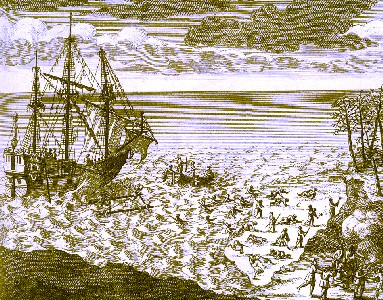
The Sinking of the Pelican in 1697. The Hudson Bay Company's Ship the
Royal
Hudson Bay Fought Her Just Before This Happened (1722)
merchant sailor facing death, disfigurement or dismemberment. This is probably why Uring's sailors demanded smart money to fight the (almost certainly) better manned and better prepared privateers for their cargo ship. This 'smart money' to be paid to those wounded during an engagement was an important incentive to action above and beyond the normal duties. "Crewmen of the Royal Hudson's Bay [in the late 17th century] refused to sail without the company's assurance that smart money would be paid in case of an engagement. Crewmen of the Falmouth-Lisbon mail packet acted similarly in February of 1705/6."6
Merchant ships weren't the only ones who were incentivized using smart money. When Woodes Rogers' privateer ships were dividing plunder from a Galleon they had taken in 1709, smart money was awarded to three men who had been wounded.
William Davis, who "was shot through the hinder-part of the Neck by the Enemy, the Wound not [being] dangerous"7 and Yerrick Derrickson who "was shot thro' between the lower Part of his Neck and Shoulder, but I believe not mortal[ly]"8, were each given "20 Rupees each, as smart Money, over and above their Shares."9 James Stratton, "a Quarter-Master belonging to the Dutchess, that was wounded ...by a Musket-Ball in his Thigh"10 was given "40 Rupees to buy him Liquor in India, in Part of Amends for his smart Money."11 Although a privateer is technically not a merchant (actually being a private naval vessel), the privateers were operating with the understanding that they would be paid out of profits from captured vessels, so smart money was an important incentive for these sailors to fight.
In addition to payment for wounding, some merchant companies also provided housing for those wounded with long-term consequences in their service. The Trinity House in Kingston upon Hull (located on the Humber Estuary in England) started out as a religious guild in the 14th century, but eventually came to be known for its charity to merchant sailors. In 1457,
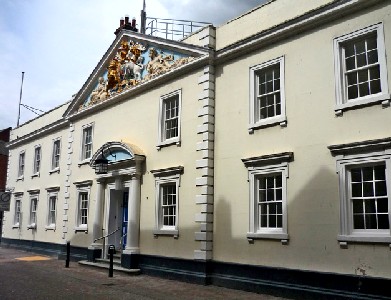
Photo - Paul Harrop - Trinity House in Hull, Built in 1756
"twenty-four masters and rectors of ships agreed to found an almshouse for mariners brought to poverty by 'infortune of the seas'."12 The almshouse appears to have been ready to receive destitute sailors by 1470.13 This was to be financed by money paid to mariners for handling and stowing cargo on ships at the Port of Hull, a practice which was eventually mandated by Henry VI.
While 'infortune of the seas' could refer to a variety of reasons a sailor might become destitute, there seems "to have been a tacit agreement that Trinity House looked after seamen and their dependants."14 The structure may have consisted of a common hall and rooms for each pensioner with a covered walk in front of them.15 In 1456 there were at least 10-11 'inmates'16, in 1541, the Hull almshouse was home to 13 brethren17 and in 1630 the number had reached 14.18 In 1682, another almshouse was founded with its management being transferred to Trinity house because of their experience in managing almshouses in 1697.19 The Trinity House continued to function through the golden age of piracy and still exists today.
The East India Company also built an almshouse for their disabled seamen. The first one came about as a result of a dishonest East India Company factor named Hugh Greete in India. Greete was arrested in 1618 for keeping the best of the diamonds he bought on behalf of the company for himself. He died in 1619 and the company seized his assets. However his will stated that part of his money was to go towards the building of a school or hospital. The company decided to honor this intention by building "an almshouse for the company's disabled seamen, their widows and orphans."20 Curiously, although Greete's money was the impetus for the almshouse, it does not appear to have been used because it was stipulated that the money would
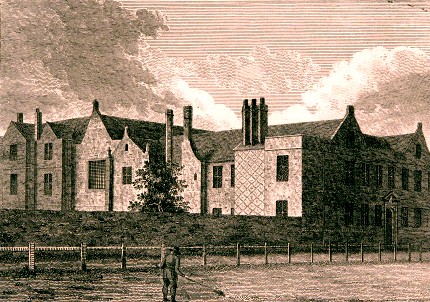
Artist: James Peller Malcolm - The East India Company Poplar Almshouse (1767)
only be given to the Company if they remembered Greete as a benefactor. They refused to honor such a man they considered a scoundrel.
Still, with the goal of establishing an almshouse in mind, the company imposed a 'rate' (basically a tax) of 2d. in 1625 "on the wages of all but its poorest men, generating £60 for the almshouse by 1626."21 The next year, Captain Thomas Styles reported to the company "that 'a large and convenient brick house' with three acres of ground in 'Blackwall' was available."22 This was located on Poplar High Street in East London. Due to the expense of demolishing the existing house and their limited funds available for the project, "the company decided to make repairs, additions or alterations, 'as by some skilfull Survaior shalbe thought meete'."23
John Ferne and Tristram Hughson were the first pensioners admitted to the almshouse in 1628. They were not the best choices; Hughson drank and swore heavily, and Ferne was expelled for bringing another man's wife into the house and having children with her. This and similar problems led to "regulations and the reading of prayers by one of the pensioners in the chapel that was part of the building" in 1635.24 The almshouse continued to be financed by a rate on the Company sailor's wages and additional bequests. By 1732, more rooms in the building were remodeled, giving them 22 rooms in total.25
So it can be seen that merchant companies made some efforts to provide for men maimed in their service. However, it was the English Navy that showed how permanently sick and wounded men could be cared for shortly before the beginning of the golden age of piracy.
1 Alexander Justice, A General Treatise of the Dominion of the Sea, 1724, p. 88; 2 Justice, p. 130; 3 Gerard Malynes, “The Ancient Sea-Laws of Oleron, Wisby and the Hanse-Towns, Still in Force", The Ancient Law-Merchant, 1686, p. 16; 4 Malynes, p. 22; 5 Malynes, p. 103; 6 Ian K. Steele, The English Atlantic, 1675-1740, 1986, p. 13; 7,8 Woodes Rogers, A Cruising Voyage Round the World, p. 177; 9 Rogers, p. 232; 10 Rogers, p. 188-9; 11 Rogers, p. 232; 12 K.J. Allison, ed., "The Trinity House", A History of the County of York East Riding, Vol. 1, the City of Kingston Upon Hull, pp. 397–407; 13 Allison, "The Trinity House"; 14 Allison, "The Trinity House"; 15 Allison, "The Trinity House"; 16 Allison, "The Trinity House"; 17 Allison, "The Trinity House"; 18 Allison, "The Trinity House"; 19 Allison, "The Trinity House"; 20 London County Council, “The East India Company’s Almshouses”, Survey of London: Volumes 43 and 44, Poplar, Blackwall and Isle of Dogs, pp. 107-11; 21 London County Council, “The East India Company’s Almshouses”; 22 London County Council, “The East India Company’s Almshouses”; 23 London County Council, “The East India Company’s Almshouses”; 24 London County Council, “The East India Company’s Almshouses”; 25 London County Council, “The East India Company’s Almshouses”

